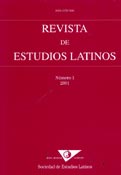The corego’s monologue in Curculius: a tour through the memory
DOI:
https://doi.org/10.23808/rel.v10i0.87826Keywords:
metatheatrical techniques; memory; parody; Plautus.Abstract
Curculio, along with a little novel plot showing conventional topics, contains certain scenic resources which are characterized by a great comic strength. In this opportunity we will pay our attention on one of them, the monologue of the corego through the forum romanum and its relationship with the memory. The route of the corego is much more than a display of metatheatrical techniques, because Plautus uses this scene to parody one of the officia oratoris, the docere the mnemonic techniques which reinforce the system of artificial memory.
Downloads
Downloads
Published
How to Cite
Issue
Section
License
Copyright (c) 2010 Revista de Estudios Latinos

This work is licensed under a Creative Commons Attribution-NonCommercial-NoDerivatives 4.0 International License.
The originals published in the printed and electronic editions of this journal are the property of the Revista de Estudios Latinos and can be circulated as long as the original source and authorship is made clear in any reproduction, full or partial, of the same, and as long as this is not done for commercial purposes.






